
Our squirrels are a mixed blessing! On the one hand, they are attractive little creatures usually (when they can be seen at all) sitting prettily. They are foreign cousins of "Squirrel Nutkin", after all. But therein lies the trouble: they are American grey squirrels which have since 1876 driven all our smaller native British red squirrels out of all the Midlands forests. And they don't eat just nuts. As can be seen in many parts of our Reserve, they feed on the bark of some trees, causing deformity or killing the trees. Not that they are entirely vegetarian: they are known to eat insects, smaller rodents, birds' eggs and nestlings when the need arises. Some folk speak of them as 'tree rats': some scientists name them Sciurus carolinensis.

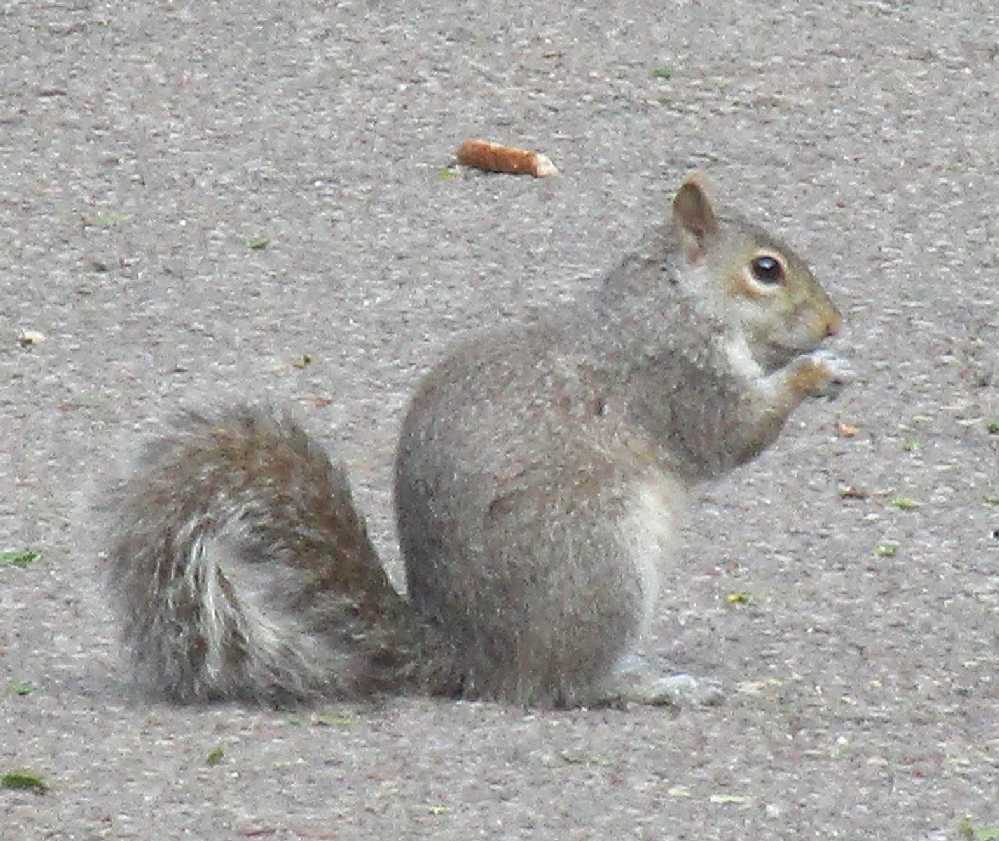 They build untidy twig-based nests known as 'dreys', easily confused with rook or crow nests. They usually act as individuals, sometimes tolerating a near neighbour, occasionally indulging in high-speed chases for unverifiable reasons. As well as their stereotypical behaviours scampering up trunks and jumping from branch to branch, they spend a lot of time on the woodland floor and occasionally venture abroad onto grassland, rarely onto tarmac.
They build untidy twig-based nests known as 'dreys', easily confused with rook or crow nests. They usually act as individuals, sometimes tolerating a near neighbour, occasionally indulging in high-speed chases for unverifiable reasons. As well as their stereotypical behaviours scampering up trunks and jumping from branch to branch, they spend a lot of time on the woodland floor and occasionally venture abroad onto grassland, rarely onto tarmac.
Majestic on the water, a beggar when duck-food is on offer, "N9H" is the surviving partner of a pair of 'mute swans' (Cygnus olor). Its vegetarian diet is derived from under water and on land, so explorations extend to several parts of the Reserve surrounding the lake.

Canada geese are pretty much perpetual visitors to Mill Green Nature Reserve. They are an introduced species, having originated where their name suggests. But unlike the grey squirrel introduction, Canada geese have fitted into the natural systems of Britain and Europe (not to mention New Zealand) without causing any serious upsets. Like other geese, they are largely vegetarian both on the water and off, grazing all the areas around the lake and enjoying visitors' contributions. (Branta canadensis.)
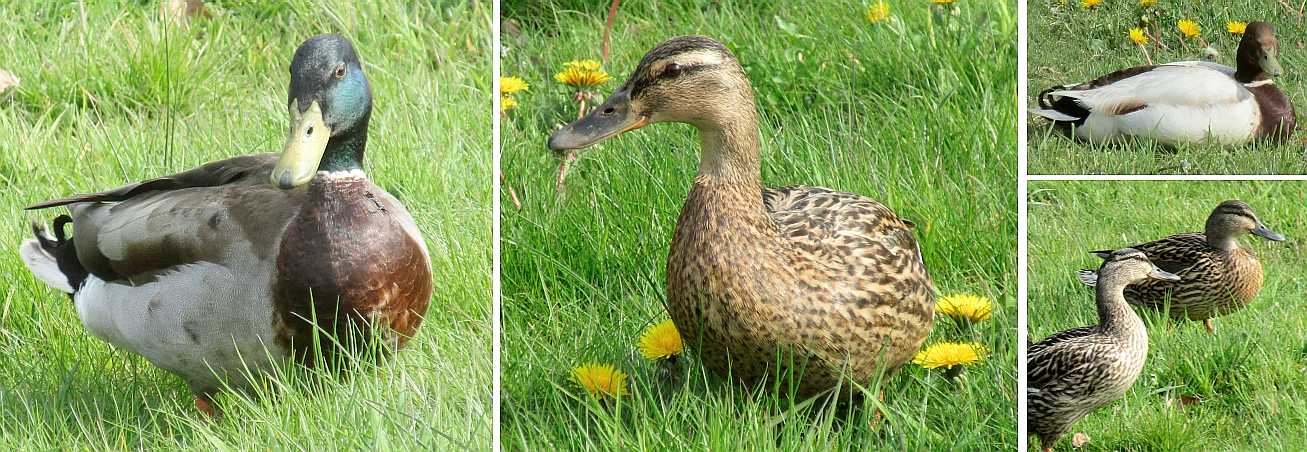
Much the commonest and most regular duck species on the Reserve is the mallard, Anas platyrhynchos. The colourful male drakes contrast with the more easily camouflaged female ducks. But it is almost characteristic of the species' genetics that colours are quite variable in both cases.

Like the geese, mallard feed both on the water and on land, but mallard supplement their vegetable diet with pretty much anything they can discover in the way of worms, beetles, flies and the like. They commonly do this as a flock but they do also explore, often singly or in pairs, the flowing brooks and the more overgrown areas of the Reserve.

Of course other birds fly over, but these buzzards (Buteo buteo), for example, cannot be regarded as native to our Nature Reserve: they are not known to nest in the area at all.

The Reserve does include indications of the presence of unseen animals. A number of 'bat boxes' have been installed, high up on trees in the oak woodland area. Obviously widely distributed, moles find a good diet and leave their characteristic molehills in both the open, grassy areas and the woodland floors.

It was explained above that portraits on this page are largely fortuitous. There is no comprehensive review of bugs and creepy crawlies, but they are vital to the ecosystem and must not be ignored.
1 • Small tortoiseshell butterfly on a dandelion: Aglais urticae, so named because the caterpillars feed on stinging or 'common' nettles, Urtica dioica.
2 • Thought to be a ringlet butterfly, Aphantopus hyperantus is rather variable in colour tone and spot pattern.
3 • Small white butterfly, Pieris rapae / Artogeia rapae, may be unpopular with cabbage growers!
4 • This is a hover fly of some sort. There is a whole family of "about six thousand species" of them.
5 • This beetle's colouring makes it fairly easy to track down. Result: Rutpela maculata or 'spotted longhorn', seen here on a wild rose.
6 • This rather unlikely-looking creature on a thistle flower is the larva of a common-or-garden ladybird, a species of Coccinella.

1 • This little creature is a 'flea beetle' simply by virtue of its being able to jump theatrically. It is not closely related to fleas: indeed, it eats leaf material. Genus and species are not known.
2 • 'Greenbottle' flies are not confined to nature reserves! There are too many types to be able to say what this one may be.
3 • Similarly, the common house fly is not confined to houses: the familiar one is Musca domestica.
4 • This is an 'Ocellate Rove' beetle, one of the Omaliinae family. It was found on wind-blown poplar catkins but is may have emerged from the leaf litter.
5 • Just an ordinary spider, discovered on the leaf litter. There must be countless similar individuals throughout the ecosystem.
6 • This is probably a large black slug (that's its name), Arion ater.
| This green shield bug (Palomena prasina) on the right was still active in late October as the oak leaves were succumbing to autumnal loss of colour. They live by sap-sucking on a wide variety of plants but are not known to cause epidemic damage. | 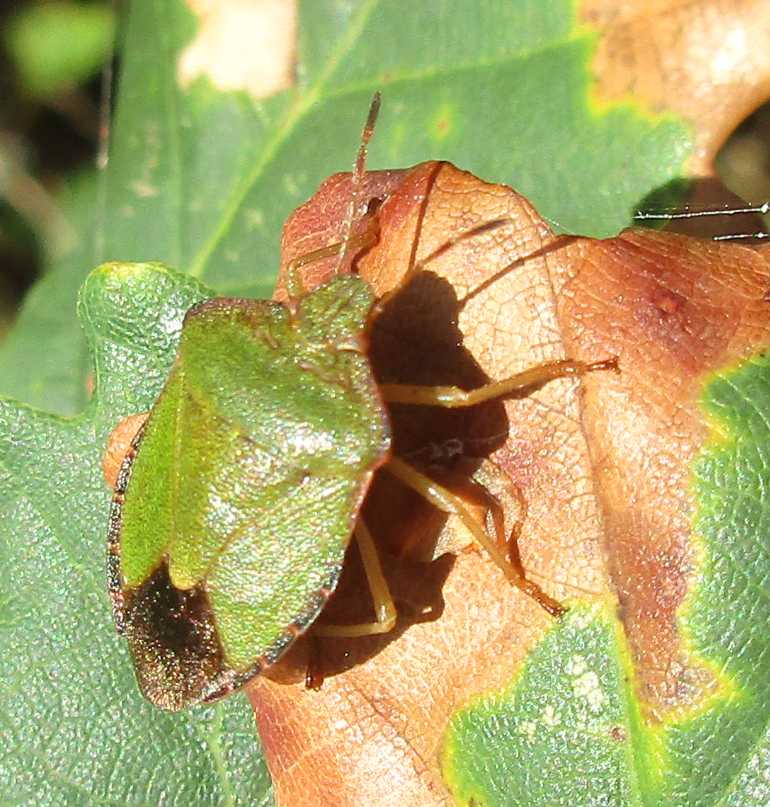 |
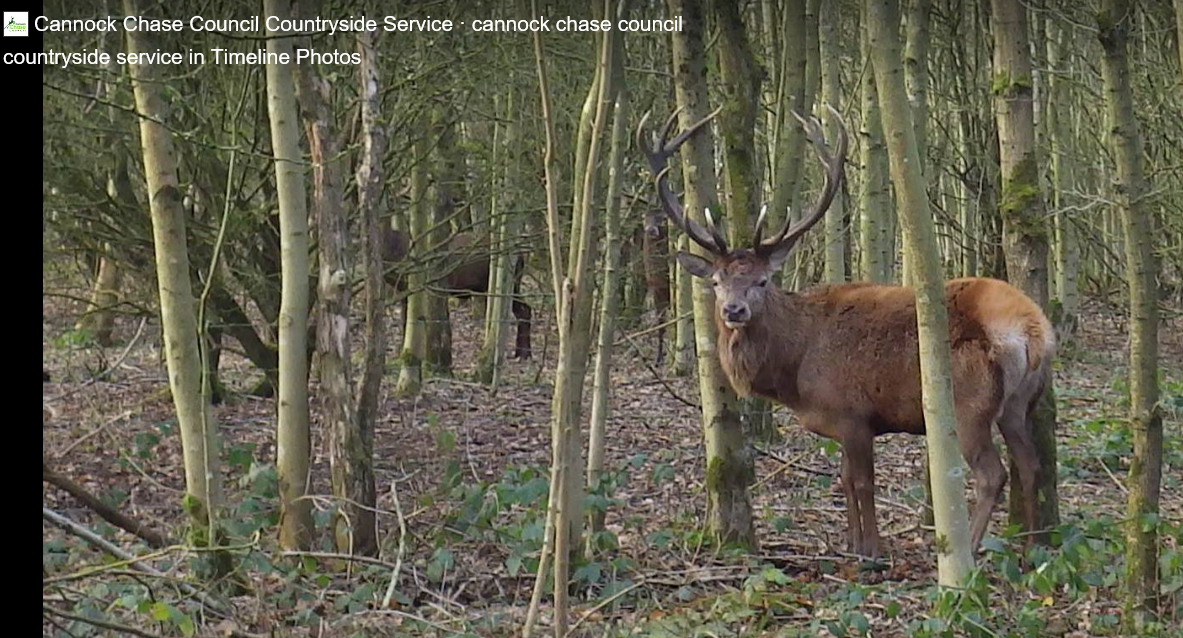 |
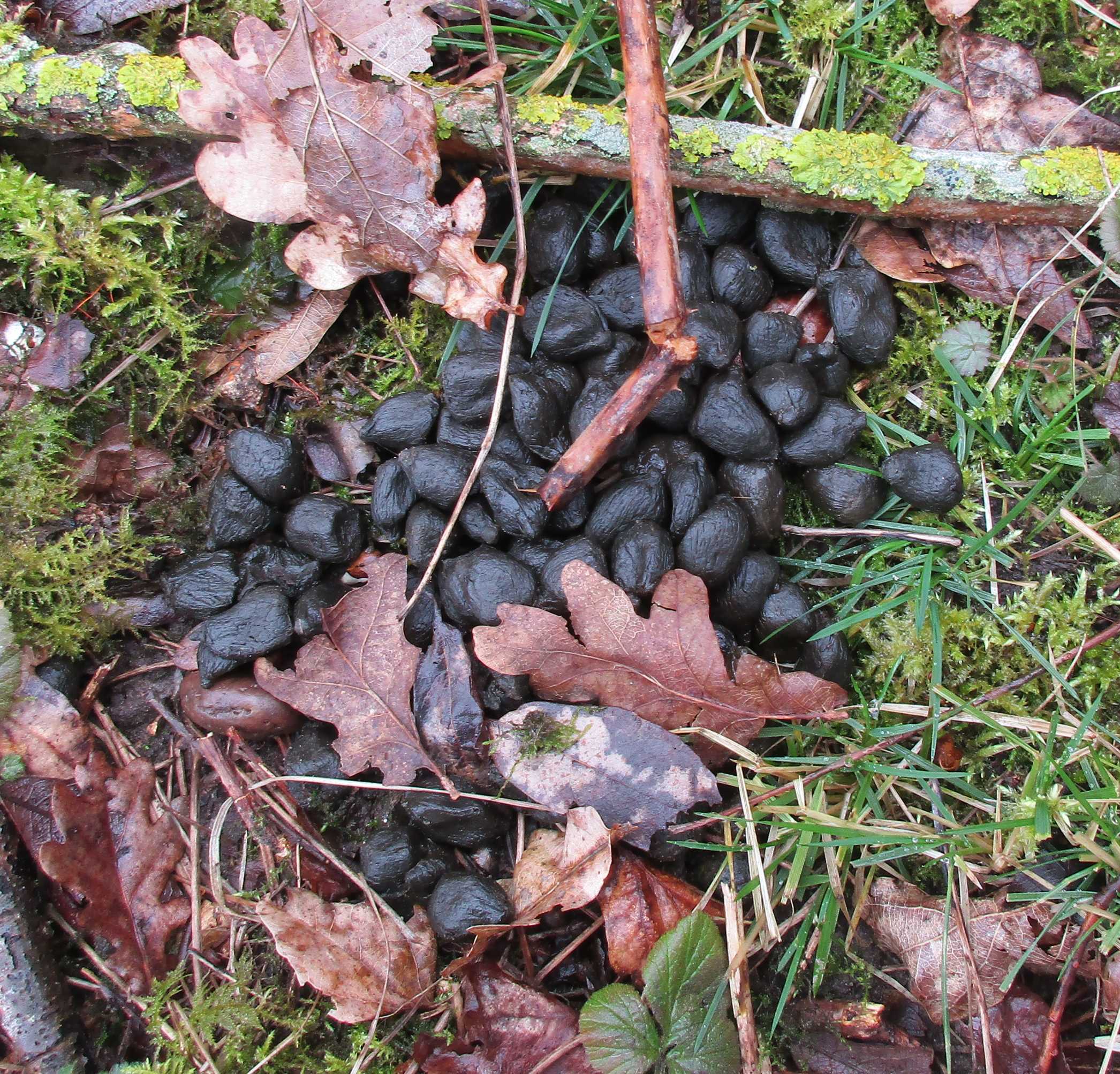 | |
| The largest and rarest visitors are the deer, visiting Mill Green from their more frequent location on Cannock Chase itself. Countryside Service staff were fortunate to capture this red deer image in January of 2018. Slightly less uncommon is evidence of their having visited! |

Just a few bird portraits. There are geese further up the page, and some of their goslings feature on the Spring page.
Our little lake or 'balancing pond' is not rich in fish. So it's only a rare exploratory grey heron (Ardea cinerea) that graces us with its presence in passing.
And having snapped a common-or-garden robin why not include it?
| Pheasants, Phasianus colchicus, like this male may be common in agricultural areas but are only occasional visitors to our Reserve. Similarly, a sparrowhawk (Accipiter nisus) may rarely be glimpsed here and is unlikely to be nesting in the immediate vicinity. | 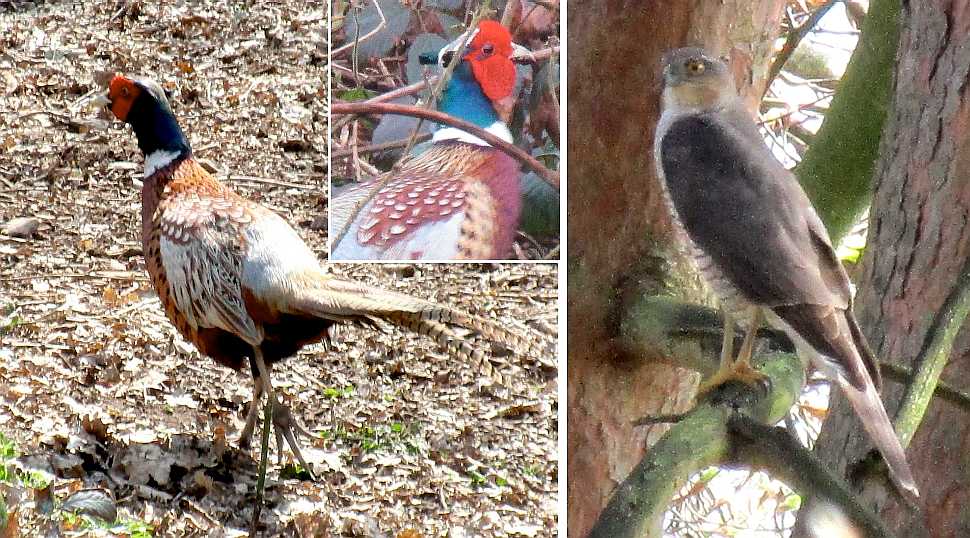 |

1 • It is possible, very occasionally, to hear the drumming of a woodpecker in our woods. Hardly ever can the bird be glimpsed in action. It is almost, but evidently not quite, impossible to photograph the great spotted woodpecker, Dendrocopus major.
2 • The rarity of heron visits is mentioned above. Good luck must have helped to yield this picture.
3 • Not 'just another duck', this winter visitor was a male teal, Anas crecca.
4 • Our "N9H" resident mute swan, caught in flighty mood.
5 • Birds of prey, 'raptors', are pretty rare in industrial areas, but the occasional buzzard (Buteo buteo) may be glimpsed by a fortunate fluke on our Reserve.